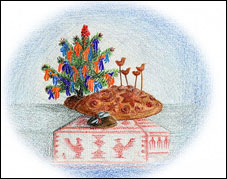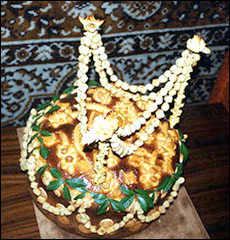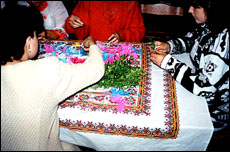|

Pre Wedding Phase
Wedding Day Phase
Post Wedding Phase
At the end of the 19th century, the custom of pre-arranging marriages is still
popular. A series of steps are taken to initiate the wedding process. They
begin with the groom's parents, who choose a prospective bride considering her
family's social and economic status: a hardworking, modest, honourable girl is
usually preferred. The appropriate age of marriage is 15-17 years for females
and 18-20 years for males. The most popular time of the year for weddings is in
late winter or early spring, roughly between Christmas and the start of Lent
before Easter. A second "wedding season" takes place after harvest time and
before the Christmas fast.
Inquiries [dopyty]
After the prospective bride is selected, preliminary representatives of the
groom and his family, usually the groom's female relatives, are chosen to
travel to the bride's home to determine whether she and her parents are likely
to accept their marriage proposal. The groom's representatives bring bread,
salt, and spirits with them. Once they arrive at the bride's home, they subtly
inquire about the willingness of the bride's parents to marry their daughter to
the proposed suitor. If they sense that the match is not agreeable to the
girl's parents, they may terminate the inquiries by changing the topic of
conversation. If they receive indications that the girl's parents, and perhaps
the girl herself, approve of the proposed suitor, they sit down and pursue the
matter further. After offering toasts, the two sides exchange ritual bread as a
sign that both parties agree to the match.
Matchmaking [svatannia]
Before matchmaking can begin, the families of the bride and groom must choose
the matchmaker [starosta] and his assistant [pidstarosta].
Although each family chooses matchmakers [starosty], the groom's matchmakers
play a more dominant role. The groom and his matchmakers visit the bride's home
with bread, salt, and spirits. Upon their arrival at the bride's home, they
knock at the window or door three times. The matchmakers enter the prospective
bride's home, present bread and salt, and begin the prescribed matchmaking
dialogue. The most popular form of the dialogue begins with the pretense that
the matchmakers are hunters who have traveled throughout the world in the
company of their prince. Once the matchmakers have finished their dialogue, it
is up to the parents to reply to the proposal. If the parents intend to refuse
the proposal, the maiden brings out glasses, an alcoholic beverage, and a
pumpkin on a plate to present to the matchmakers. However, if the maiden's
parents accept their proposal, the maiden brings out two embroidered ritual
cloths on a plate. The ritual cloths are tied over the shoulders of the
matchmakers. She also brings an embroidered kerchief to place in the
prospective bridegroom's belt. Then the maiden's parents signal their formal
agreement to the match by ceremonially exchanging bread with the visitors. In
turn, they offer liquor to the householders and make arrangements with them for
the day of the betrothal.
Inspection [ohliadyny / rozhliadyny]
Inspection provides the bride's family with an opportunity to verify the
groom's family's economic situation, which will have a direct effect on the
bride's future. Conducted by the bride's parents and relatives, the inspection
takes place without the bride being present. If the bride's relatives are
satisfied, then the day for betrothal is set. If the family is not satisfied
with the economic situation, then the bread exchanged at the matchmaking is
returned, and the prospective match dissolved.
Betrothal [zaruchyny]
With the future bride and groom's relatives all present in the house of the
young woman's family, the betrothal takes place. The principal elements of
matchmaking are repeated. The betrothed couple is blessed with bread. The
starosta binds the couple's hands to each other and leads them to the wedding
seat [posad] in the place of honour at the table. After the festivities in the
future bride's home, another celebration takes place in the home of the
prospective groom: it is called zapoiny.
Floor plan of a traditional Ukrainian house

1. Entrance hall (siny)
2. Small living space(mala khata)
3. Storage room (komora)
4. Oven (pich)
5. Bed (lizhko)
6. Larger living space used for festive occasions (svitla khata)
7. Posad under icons
8. Table (stil')
Marriage banns [zapovidi]
In the 19th century, the church is the core institution authorized to contract
and register marriages. The young couple has to inform the local priest of
their forthcoming marriage a few weeks before the ceremony. The priest tests
their basic knowledge of religion. In the course of three Sunday services, he
announces the decision of the couple to enter into marriage. In times of
serfdom up to the mid 1800s, the young people might also need to get permission
from the landlord for their marriage.
Dowry [vino]
After the betrothal, the parents of both sides arrange more details about the
dowry and the wedding. The dowry contains property for the new household
contributed by the bride and her family. The families decide where the couple
will live, often in the home of the groom's family at first. They also
negotiate what fields, implements, animals and other necessities will be given
to the couple if the new family is to set up its own household and farm.
Invitations [zaprosyny]
On Saturday, the day before the wedding, the bride, wearing a wreath of
periwinkle [barvinok] and accompanied by her bridesmaids [druzhky], invites the
guests to her wedding. First, the bridesmaids gather at the bride's home where
the bride's mother blesses them with holy water. The "invitation party" then
proceeds on its rounds. When it enters a house, the bride bows to each
resident, and one of the bridesmaids puts a loaf of ritual bread on the table.
Then the bride and her bridesmaids recite their invitation three times: "My
father and mother invite you, and I invite you for bread, salt, and to the
wedding." Once the invitation has been offered, gifts such as bread, chickens,
or money are given to the bride. In the same way, the groom and his best man invite his family's
guests to the wedding celebrations that will take place at his family's home.
 Wedding
tree [hil'tse or derevtse] Wedding
tree [hil'tse or derevtse]
The hil'tse is a decorated conifer branch inserted into a ritual loaf of bread.
The bride and groom each have their own hil'tse. The groom's best men make his hil'tse, whereas the bride's
hil'tse is made by her bridesmaids. Tiny bouquets comprised of periwinkle,
cranberries, oats, feathers, herbs, garlic, and coins are made for it. These
items are bound together with colored wool, silk, or ribbons. When the
bouquet-decorations are ready, they are attached to the branch. The mother,
father, or brother places the first bouquet on the top. Then everyone
joins in to decorate the hil'tse in order of their social rank in relation to
the bride or groom. People sing special songs as the hil'tse is being
decorated.
 Wedding
breads [korovai] Wedding
breads [korovai]
Made of flour contributed by all the kin, the wedding breads are symbolically
significant. In order to bake a good korovai, the korovainytsi, the women who
prepare it, must be selected from among those who are respectable, happily
married young or middle-aged wives. The korovainytsi, singing solemn festive
songs, decorate the top of the wedding bread with figures of pine-cones, doves,
geese and other forms, shaped out of dough. Branches may also be used to
decorate the korovai.
Maiden's evening [divych vechir]
The divych vechir takes place on the eve of the wedding. At this time the
bride-to-be bids farewell to her maiden friends. Only the bride's girlfriends
are present. Unmarried women in 19th century Ukrainian villages generally wear
their hair in long braids, and the bride's hair is unbraided symbolically.
Throughout the night the girls sing sad songs which make reference to the
separation of the bride from her family and from maidenhood, and to her
potentially difficult future life with the in-laws.
 Wreath-weaving
[vinkopletennia] Wreath-weaving
[vinkopletennia]
The vinkopletennia is a ceremony in which wreaths are woven, to be worn by the
couple on the wedding day. The bridesmaids and older women [svakhy] usually
conduct this ceremony. First of all, they gather periwinkle [barvinok] and
other plants from the garden. Then svakhy first spread the periwinkle on the
table and place a loaf of bread [kolach] nearby. Once the weaving begins, the
svakhy sing, asking God to bless the couple's future. Sometimes garlic is
attached to the wreath to protect the wearer against evil. Coins can also be
attached to bring the couple good luck. Finally, the completed wreaths are
placed on the kolach and blessed by the bride's parents.
|




